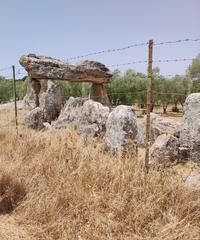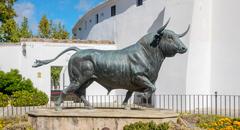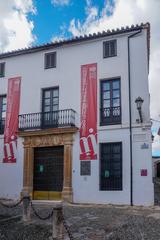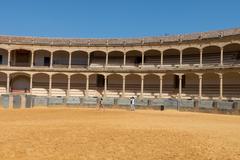Visiting Arco del Cristo, Ronda, Spain: Complete Guide, Tickets, Hours, and Tips
Date: 14/06/2025
Introduction
The Arco del Cristo is one of Ronda’s most iconic and historically significant landmarks, dramatically set on the edge of the El Tajo gorge in the heart of Andalusia. This ancient gateway, originally part of Ronda’s formidable medieval walls, provides not only a tangible link to the city’s Roman, Moorish, and Christian past but also some of the finest panoramic views in Spain. Whether you’re a history enthusiast, a photographer, or simply a curious traveler, this guide covers everything you need to know about visiting the Arco del Cristo—from its origins and architectural highlights to practical visitor information, travel tips, and nearby attractions.
For further research and travel advice, consult trusted sources such as Discover Ronda, Nomads Travel Guide, and Jetset Together.
Table of Contents
- Origins and Strategic Importance
- Architectural Features and Defensive Role
- Historical Evolution: From Moors to Christians
- Cultural and Symbolic Significance
- Visiting Information: Hours, Tickets, and Accessibility
- Travel Tips and Nearby Attractions
- Frequently Asked Questions (FAQ)
- Conclusion and Final Tips
- References
Origins and Strategic Importance
The Arco del Cristo—also known as the Christ’s Arch or Puerta de los Molinos—dates back to the Moorish period (8th–15th centuries) and was a key defensive gateway in Ronda’s ancient walls. Built originally using Moorish tapial (rammed-earth) construction, it protected the access route to the vital flour mills powered by the Guadalevín River below. The natural barrier of the Tajo gorge, combined with robust city walls, made Ronda a highly coveted stronghold through centuries of Roman, Moorish, and Christian rule (Discover Ronda; Nomads Travel Guide).
After the Reconquista in 1485, the arch was re-dedicated and adorned with Christian symbols, marking Ronda’s transition from Islamic to Christian rule.
Architectural Features and Defensive Role
The Arco del Cristo is a classic example of Moorish military architecture, with a horseshoe-shaped arch and sturdy stonework. Its understated elegance and durability reflect the pragmatic yet refined approach of Islamic engineers. The arch was integrated into a double line of defensive walls, reinforced with towers and narrow passageways to maximize security (Discover Ronda).
Strategically located on the western edge of Ronda, the gate allowed defenders to control movement between the fertile valley and the fortified plateau, ensuring the city had access to essential resources during sieges.
Historical Evolution: From Moors to Christians
Following the Christian conquest in 1485, the Arco del Cristo was adapted to reflect its new role in a re-Christianized city. A shrine dedicated to Christ was built into the stonework, and the gate’s name changed to symbolize the new religious order. Despite these updates, much of its original Moorish character and structure remain intact, offering visitors a rare glimpse of Ronda’s multicultural past (Nomads Travel Guide; Jetset Together).
Restoration efforts over the centuries have ensured the arch’s preservation, maintaining its historical integrity while making it accessible to modern visitors (Magnificent World).
Cultural and Symbolic Significance
The Arco del Cristo is more than a military relic. It stands as a symbol of Ronda’s layered identity, shaped by Roman, Islamic, and Christian influences. Its position as a gateway between the city and countryside, and its blend of religious iconography, make it a powerful emblem of Andalusia’s multicultural heritage (Spanish Plains).
Today, the arch is a focal point for local festivals, cultural events, and walking tours, as well as a favorite subject for photographers and artists, thanks to its breathtaking views of the Puente Nuevo and El Tajo gorge (Jetset Together).
Visiting Information: Hours, Tickets, and Accessibility
- Opening Hours: The Arco del Cristo is outdoors and open 24/7. Visit during daylight for safety and best views (Oway Tours).
- Entry Fees: Free—no ticket is required. Some guided tours that include the arch may charge a fee (Nomads Travel Guide).
- Accessibility: The path to the arch includes stairs, uneven surfaces, and steep inclines. While most visitors can manage the walk, it is not suitable for wheelchairs or strollers. Good footwear is essential.
- Facilities: No public restrooms or shops at the arch. Facilities are available in Ronda’s old town.
- Guided Tours: Many Ronda walking tours include the Arco del Cristo; check with local operators or the official tourism office.
Travel Tips and Nearby Attractions
Getting There
- Walking: From Plaza de España, cross Puente Nuevo, continue onto Calle Tenorio, and descend via Plaza de María Auxiliadora. The path is steep and moderately challenging (Andalucia.com; Nomads Travel Guide).
- Parking: Limited near the arch. Use paid car parks like Parking El Castillo or Parking Plaza del Socorro and walk in (The Viva La Vita).
- Public Transport: Ronda’s train station is a 10-minute walk from the historic center.
When to Visit
- Best Months: Spring (March–May) and autumn (September–November) for mild weather and vibrant landscapes (Champion Traveler).
- Best Time of Day: Early morning or late afternoon for softer light and fewer crowds. Sunset provides beautiful photography conditions (Explored by Marta).
Nearby Attractions
- Puente Nuevo: The city’s iconic bridge is visible from the arch.
- Espíritu Santo Church: 16th-century church built on Moorish tower remains.
- Murallas de Ronda and Puerta del Viento: Continue your walking tour along Ronda’s medieval walls (We Solo Travel).
- Paseo de los Ingleses: A stunning cliff-edge promenade.
Practical Tips
- Footwear: Sturdy, comfortable shoes are essential.
- Water & Sun Protection: Bring water, sunscreen, and a hat.
- Safety: Watch for steep drops and uneven paths. Supervise children closely.
- Respect: Do not climb or sit on the arch. Carry out all litter.
Frequently Asked Questions (FAQ)
Q: Is there an entrance fee or do I need tickets?
A: No, the Arco del Cristo is free to visit at any time.
Q: What are the best hours for visiting and photography?
A: Late afternoon or early evening for the best lighting and fewer crowds.
Q: Is the site accessible for people with disabilities?
A: The steep, uneven path is not suitable for wheelchairs or strollers.
Q: Are guided tours available?
A: Yes, many Ronda city tours include the arch.
Q: Can I park near the arch?
A: Parking near the arch is limited; use city center car parks and walk.
Conclusion and Final Tips
The Arco del Cristo is a living testament to Ronda’s resilience, multiculturalism, and architectural ingenuity. Its blend of Moorish and Christian features, historical significance, and stunning location make it a must-see for visitors. To maximize your experience, plan your visit for early morning or late afternoon, wear proper footwear, and explore nearby historic sites for a well-rounded understanding of Ronda’s past.
For more in-depth travel insights and up-to-date information, consult resources like Nomads Travel Guide, Discover Ronda, and the official Ronda tourism website.
Download the Audiala app for personalized maps, guided tours, and local tips, and follow us on social media for the latest updates and travel inspiration.



